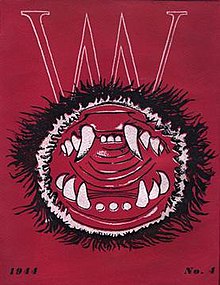VVV (magazine)

VVV was a journal devoted to the dissemination of Surrealism, published in New York City from 1942 through 1944.
Only three issues of VVV were ever produced. However, it provided an outlet for European Surrealist artists, temporarily displaced from their home countries by World War II, to communicate with American artists.
VVV was the direct product of the leading Surrealists of the day. The journal was edited by David Hare in collaboration with Marcel Duchamp, André Breton, and Max Ernst. VVV's editorial board also enlisted a number of associated thinkers and artists, including Aimé Césaire, Philip Lamantia, and Robert Motherwell. Each edition focused on "poetry, plastic arts, anthropology, sociology, (and) psychology," and was lavishly illustrated by a wide range of Surrealist artists, including Giorgio de Chirico, Claude Levi-Strauss, Roberto Matta, and Yves Tanguy.
The journal was experimental in format as well as in content. Editions of VVV contained fold-out pages, differently sized sheets and types of paper, and bold typography and color. The second issue's back cover featured one of Duchamp's "readymades" : a cutout female figure "imprisoned" by a piece of actual chicken wire.
See also
- Acéphale - a review created by Georges Bataille which from 1936 to 1939
- Documents, a Surrealist journal edited by Georges Bataille from 1929 through 1930
- Minotaure - was a primarily surrealist-oriented publication founded by Albert Skira in Paris from 1933 to 1939
- La Révolution surréaliste - the surrealist publication between 1924 and 1929 in Paris
- View - an American art magazine published in the 1940s
